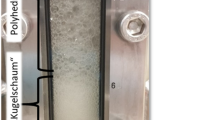Abstract
In laboratory culture, strains of the actinomycete Frankia grow slowly and form dense mycelial pellets. In this study, we have shown that by adding the anionic polymer Carbopol 941® to liquid growth media, dispersed growth of Frankia is improved. Cell protein measurements indicated higher biomass production in cultures maintained in media supplemented with Carbopol. Fluorescence staining and microscopy were used to compare viability of well-dispersed mycelia and pellets.
Similar content being viewed by others
References
Benson D R and Schultz N A 1990 Physiology and biochemistry of Frankia in culture. In The Biology of Frankia and Actinorhizal Plants. Eds. C R Schwintzer and J D Tjepkema. pp. 107–127. Academic Press, Inc., San Diego, CA.
Benson, D R and Silvester W B 1993 Biology of Frankia strains, actinomycete symbionts of actinorhizal plants. Microbiol. Rev. 57, 293–319.
Blom J 1981 Utilization of fatty acids and NH4 + by Frankia AvcI1. FEMS Microbiol. Let. 10, 143–145.
Calam C T 1969 The evaluation of mycelial growth. In Methods in Microbiology. Eds. J R Norris and D W Ribbons. pp. 567–591, Academic Press, New York.
Callaham D, DelTredici P and Torrey JG 1978 Isolation and cultivation in vitro of the actinomycete causing root nodulation in Comptonia. Science. 199, 899–902.
CarÚ M 1993 Characterization of native Frankia strains isolated from chilean shrubs (Rhamnaceae). Plant Soil 157, 137–145.
Elmayergi H and Scharer J M 1973 Physiological studies on Aspergillus niger fermentation with polymer additive. J. Gen. Appl. Microbiol. 19, 385–392.
Elmayergi H Scharer J M and Moo-Young M 1973 Effects of polymer additives on fermentation parameters in a culture of A. niger. Biotechnol. Bioeng. 15, 845–859.
Hobbs G, Frazer C M, Gardner D C J, Cullum J A and Oliver S G 1989 Dispersed growth of Streptomyces in liquid culture. Appl. Microbiol. Biotechnol. 31, 272–277.
Jones P D, Moore D and Trinci A P J 1988 Effects of Junlon and Hostacerin on the electrokinetic properties of spores of Aspergillus niger, Phanerochaete chrysosporium and Geotrichum candidum. J. Gen. Microbiol. 134, 235–240.
Lowry O H, Rosenbrough N J, Farr A L and Randall R J 1951 Protein measurement with the Folin phenol reagent. J. Biol. Chem. 193, 265–275.
Murry M A, Fontaine M S and Torry J G 1984 Growth kinetics and nitrogenase induction in Frankia sp. HFPArI3 grown in batch culture. Plant Soil 78, 61–78.
Noridge N A and Benson D R 1986 Isolation and nitrogen-fixing activity of Frankia sp. strain CpI1 vesicles. J. Bacteriol. 166, 301–305.
Peterson G L. 1979 Review of the Folin phenol protein quantitation method of Lowry, Rosebrough, Farr and Randall. Anal. Biochem. 100, 201–220.
Prosser J I and Tough A J 1991 Growth mechanisms and growth kinetics of filamentous microorganisms. Biotechnology 10, 253–274.
Ringø E, Clausen E, Løvaas E, Van Ghelue M, and Solheim B. 1995 Effects of extracts of Alnus glutinosa seeds on growth of Frankia strain ArI3 under static and fermentor culture conditions. Plant Soil 176, 283–288.
Schwencke J 1991 Rapid, exponential growth and increased biomass yield of some Frankia strains in buffered and stirred medium (BAP) with phosphatidylcholine. Plant Soil 137, 37–41.
Selim S and Schwencke J 1994 1,2-Dipalmitoyl phosphatidylcholine, 1,2-dipalmitoyl phosphatidic acid or 1,2-dipalmitoyl-sn-glycerol inhibit sporangia formation and promote exponential growth of various Frankia isolates from the Casuarinaceae family. Soil. Biol. Biochem. 26, 569–575.
Selim S, Delacour S, Schwencke J 1996 Specific long-chain fatty acids promote optimal growth of Frankia: accumulation and intracellular distribution of palmitic and propionic acid. Arch. Microbiol. 165, 252–257.
Tisa L, McBride M and Ensign J C 1983 Studies of growth and morphology of Frankia strains EAN1pec, EuI1c, CpI1, and ACN1 AG. Can. J. Bot. 61, 2768–2773.
Trinci, A P J 1983 Effect of Junlon on morphology of Aspergillus niger and its use in making turbidity measurements of fungal growth. Trans. Br. Mycol. Soc. 81, 408–412.
Zhang X and Benson D R 1992 Utilization of amino acids by Frankia sp. strain CpI1. Arch. Microbiol. 158, 256–261.
Zhang Z, Lopez M F and Torrey J G 1984 A comparison of cultural characteristics and infectivity of Frankia isolates from root nodules of Casuarina species. Plant Soil 78, 79–90.
Author information
Authors and Affiliations
Corresponding author
Rights and permissions
About this article
Cite this article
Harriott, O.T., Bourret, A. Improving dispersed growth of Frankia using Carbopol. Plant and Soil 254, 69–74 (2003). https://doi.org/10.1023/A:1024998829163
Issue Date:
DOI: https://doi.org/10.1023/A:1024998829163




